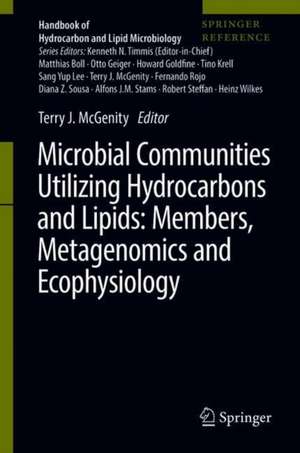Microbial Communities Utilizing Hydrocarbons and Lipids: Members, Metagenomics and Ecophysiology: Handbook of Hydrocarbon and Lipid Microbiology
Editat de Terry J. McGenityen Limba Engleză Hardback – 11 iul 2019
This book provides comprehensive, authoritative discussions about microbial communities in environments that are rich in hydrocarbons, crude oil or lipids. It encompasses natural environments, such as tar sands, oil seeps and reservoirs, as well as habitats where methane is produced. Equally, the book deals with habitats that have been influenced by human activity, including oil-contaminated soils, aquifers, coast and seas. The book opens with a series of chapters considering the contemporary approaches used to investigate microbial communities.
Preț: 1714.42 lei
Preț vechi: 2255.82 lei
-24% Nou
Puncte Express: 2572
Preț estimativ în valută:
328.09€ • 356.26$ • 275.60£
328.09€ • 356.26$ • 275.60£
Carte tipărită la comandă
Livrare economică 18-24 aprilie
Preluare comenzi: 021 569.72.76
Specificații
ISBN-13: 9783030147846
ISBN-10: 3030147843
Pagini: 400
Ilustrații: XXIII, 352 p. 34 illus., 20 illus. in color.
Dimensiuni: 155 x 235 mm
Ediția:1st ed. 2019
Editura: Springer International Publishing
Colecția Springer
Seria Handbook of Hydrocarbon and Lipid Microbiology
Locul publicării:Cham, Switzerland
ISBN-10: 3030147843
Pagini: 400
Ilustrații: XXIII, 352 p. 34 illus., 20 illus. in color.
Dimensiuni: 155 x 235 mm
Ediția:1st ed. 2019
Editura: Springer International Publishing
Colecția Springer
Seria Handbook of Hydrocarbon and Lipid Microbiology
Locul publicării:Cham, Switzerland
Cuprins
Microbial Communities Responding to Deep-Sea Hydrocarbon Spills;- Impact of Petroleum Contamination on Microbial Mats;- Phototroph-Heterotroph Oil-Degrading Partnerships;- Microbial Ecology of Marine Environments Chronically Polluted by Petroleum;- Microbial Communities in Hydrocarbon-Polluted Harbors and Marinas;- Hydrocarbon-Degrading Microbial Communities in Natural Oil Seeps;- Anaerobic Methane Oxidizers;- Methanotrophy in Acidic Soils, Including Northern Peatlands;- Microbial Communities in Hydrocarbon-Contaminated Desert Soils;- Surface and Subsurface Coal Environments: From Environmental Formation and Chemistry to Microbial Communities;- Microbial Communities in Oil Shales, Biodegraded and Heavy Oil Reservoirs, and Bitumen Deposits;- Mechanisms and Monitoring of Oil Reservoir Souring Control by Nitrate or Perchlorate Injection ;- Microbial Communities in Oil Sands Tailings: Their Implications in Biogeochemical Processes and Tailings Management;- Microbial Ecology of Naphthenic Acid (NA) Degradation;- Fungal Communities in Hydrocarbon Degradation;-
Notă biografică
Terry McGenity is a Reader at the University of Essex, UK. His PhD, investigating the microbial ecology of ancient salt deposits (University of Leicester), was followed by postdoctoral positions at the Japan Marine Science and Technology
Centre (JAMSTEC, Yokosuka) and the Postgraduate Research Institute for Sedimentology (University of Reading). His overarching research interest is to understand how microbial communities function and interact to influence major biogeochemical processes. He worked as a postdoc with Ken Timmis at the University of Essex, where he was inspired to investigate microbial interactions with hydrocarbons at multiple scales, from communities to cells, and as both a source of food and stress. He has broad interests in microbial ecology and diversity, particularly with respect to carbon cycling (especially the second most abundantly produced hydrocarbon in the atmosphere, isoprene), and is driven to better understand how microbescope with, or flourish in hypersaline, desiccated and poly-extreme environments.
He was already section editor at the first edition of this multi-volume Handbook of Hydrocarbon and Lipid Microbiology (2010), and he is co-editor for the 17-volume Hydrocarbon and Lipid Microbiology Protocols 2016.
Caracteristici
Comprehensive, authoritative discussions about microbial communities utilizing hydrocarbons and lipids Particular attention is given to the identification of the microbial community members, their metagenomics and ecophysiology Experts of the field explore insights into functions and interactions of microbial communities using contemporary methods










